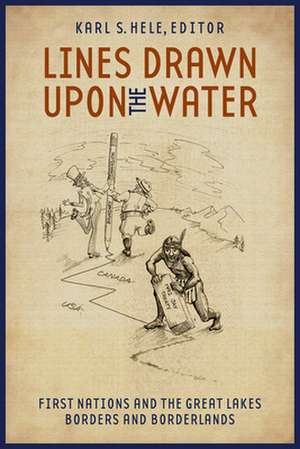Lines Drawn Upon the Water: Indigenous Studies
Editat de Karl S. Heleen Limba Engleză Paperback
The First Nations who have lived in the Great Lakes watershed have been strongly influenced by the imposition of colonial and national boundaries there. The essays in Lines Drawn upon the Water examine the impact of the Canadian--American border on communities, with reference to national efforts to enforce the boundary and the determination of local groups to pursue their interests and define themselves. Although both governments regard the border as clearly defined, local communities continue to contest the artificial divisions imposed by the international boundary and define spatial and human relationships in the borderlands in their own terms.
The debate is often cast in terms of Canada's failure to recognize the 1794 Jay Treaty's confirmation of Native rights to transport goods into Canada, but ultimately the issue concerns the larger struggle of First Nations to force recognition of their people's rights to move freely across the border in search of economic and social independence.
Preț: 303.40 lei
Nou
58.06€ • 60.74$ • 48.23£
Carte tipărită la comandă
Livrare economică 03-17 aprilie
Specificații
Cuprins
Table of Contents for
Lines Drawn upon the Water: First Nations and the Great Lakes Borders and Borderlands, edited by Karl S. Hele
List of Illustrations and Maps
Acknowledgements
"Drawing/Erasing the Border" | L. Trecore
Introduction | Karl S. Hele
1. "We have no spirit to celebrate with the great [1893] Columbia Fair": Aboriginal Peoples of the Great Lakes Respond to Canadian and United States Policies During the Nineteenth Century | Edmund J. Danziger, Jr.
2. Cross-border Treaty-signers: The Anishinaabeg of the Lake Huron Borderlands | Phil Bellfy
3. From Intercolonial Messenger to "Christian Indian": The Flemish Bastard and the Mohawk Struggle for Independence from New France and Colonial New York in the Eastern Great Lakes Borderland, 1647-1687 | Mark Meuwese
4. The Anisinaabeg and Métis in the Sault Ste. Marie Borderlandss: Confronting a Line Drawn upon the Water | Karl S. Hele
5. In the Shadow of the Thumping Drum: The Sault Métis: The People In-Between | Alan Knight and Janet Chute
6. "Those freebooters would shoot me like a dog": American Terrorists and Homeland Security in the Journals of Ezhaaswe (William A. Elias [1856-1929]) | David T. McNab
7. Shifting Boundaries and the Baldoon Mysteries | Lisa Philips and Allan K. McDougall
8. The Baldoon Settlement: Rethinking Sustainability | Rick Fehr
9. Nativism's Bastard: Neolin, Tenskwatawa, and the Anishinabeg Methodist Movement | Catherine Murton Stoehr
10. Borders Within: Anthropology and the Six Nations of the Grand River | Michelle A. Hamilton
11. The Grand General Indian Council of Ontario and Indian Status Legislation | Norman Shields
12. "This is a pipe and I know hash": Louise Erdrich and the Lines Drawn upon the Waters and the Lands | Ute Lischke
Notes
Bibliography
List of Contributors
Index
Contributors' Bios
Phil Bellfy is an associate professor in the American Indian Studies program at Michigan State University. He is also an enrolled member of the White Earth Band of Minnesota Chippewa and is active in the Native community.
Janet E. Chute teaches anthropology and ethnohistory at Mount Saint Vincent University, and is an adjunct professor with the School for Resource and Environmental Studies at Dalhousie University. She acts as a consultant in land claims and identity cases with many Aboriginal nations across Canada.
Edmund J. Danziger Jr., Distinguished Teaching Professor at Bowling Green University in Ohio, has written extensively on Great Lakes Aboriginal history topics-north and south of the international border.
Rick Fehr is a doctoral student in the Faculty of Environmental Studies at York University, where he is researching the historic and contemporary relationships between Anishinaabe and settler communities in southwestern Ontario. His research is aimed at exploring how these relationships can enact positive land ethics.
Michelle A. Hamilton is a postdoctoral fellow at the University of Guelph researching the history of amateur archaeological collecting and has worked in museums across Canada.
Karl S. Hele is an Anishinabeg historian, the Director of the First Nations Studies program and assistant professor of anthropology and history at the University of Western Ontario.
Alan Knight is an Anglican clergy and archivist for the Diocese of Algoma and a sessional lecturer in Canadian history at Algoma University College in Sault Ste. Marie.
Ute Lischke teaches German literature, film studies, and cultural perspectives at Wilfrid Laurier University, where she is associate professor in the Department of English and Film Studies.
Allan K. McDougall, professor emeritus from the University of Western Ontario, is a political scientist whose expertise is in political communication, public policy, and law.
David T. McNab is a Métis historian who has worked for three decades on Aboriginal land and treaty rights issues in Canada. David teaches in the School of Arts and Letters in the Atkinson Faculty of Liberal and Professional Studies at York University in Toronto, where he is associate professor of Indigenous Studies. Since 1992 he has also been a claims advisor for Nin.Da.Waab.Jig., Walpole Island Heritage Centre, Bkejwanong First Nations.
Mark Meuwese is assistant professor in the history department of the University of Winnipeg. His research interests include Indigenous peoples in the early modern world.
Catherine Murton Stoehr is a doctoral student at Queen's University. Her dissertation discusses the Anishinabe encounter with Methodism in early-nineteenth-century Upper Canada.
Lisa Philips, professor and chair of anthropology at the University of Alberta, is a linguistic anthropologist who has worked extensively on First Nationsstate relations.
Norman Shields is a historian for Parks Canada. His principal research interest is inter-village Anishinabek alliances in the nineteenth and twentieth centuries.















